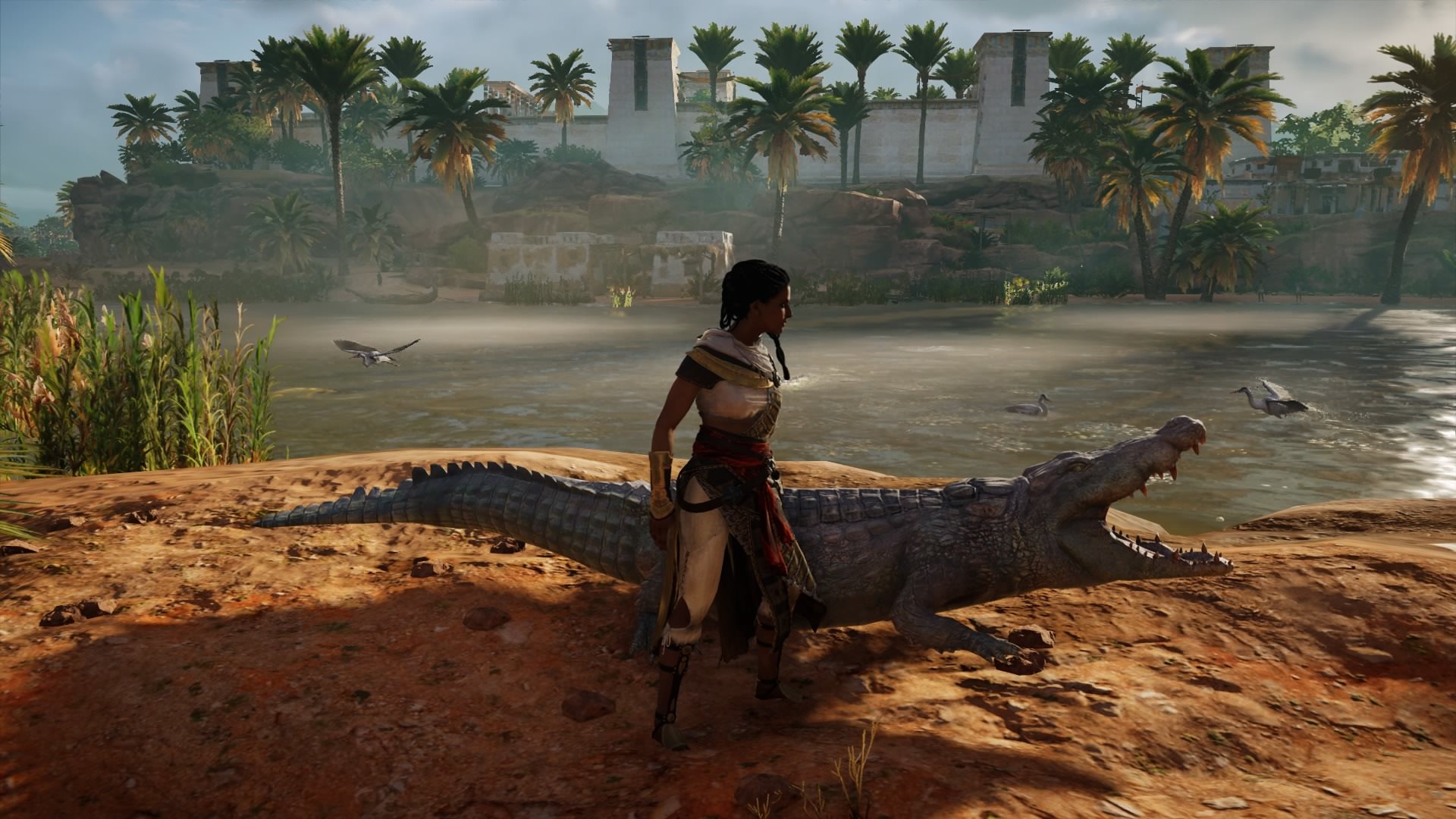So it took me a while to start playing Assassin’s Creed: Origins, and the truth is, I haven’t finished it. I who am scared of dying in videogames ever since Super Mario Bros on the original NES, has been roaming Ptolemaic Egypt for over 80 hours now, sneaking up on countless Romans in order to unashamedly slit their throat. Due to clumsiness I occassionally end up in frontal battle (which I am terribly bad at), causing concerned remarks from my mother (who loves to watch, by the way). ‘You are a different person when you start bashing buttons…’ she contemplates. Apparently I swear violently during these episodes.
Being the nerd that I am, I originally bought the game for PC in order to access discovery mode, which allowed me to walk around and experience all of the lovely 3D world without getting killed. I have actually talked about the game (before playing it) on national radio, so I felt I ought to form a good Egyptological opinion on it. My laptop is not the most powerful though, so the game didn’t really run very well. Fortunately my sister’s boyfriend was ditching his old PS4, so I could obtain a proper console. Only after I also gained access to a modern tv (as in: dating to this millenium) was I finally able to thoroughly enjoy the game.
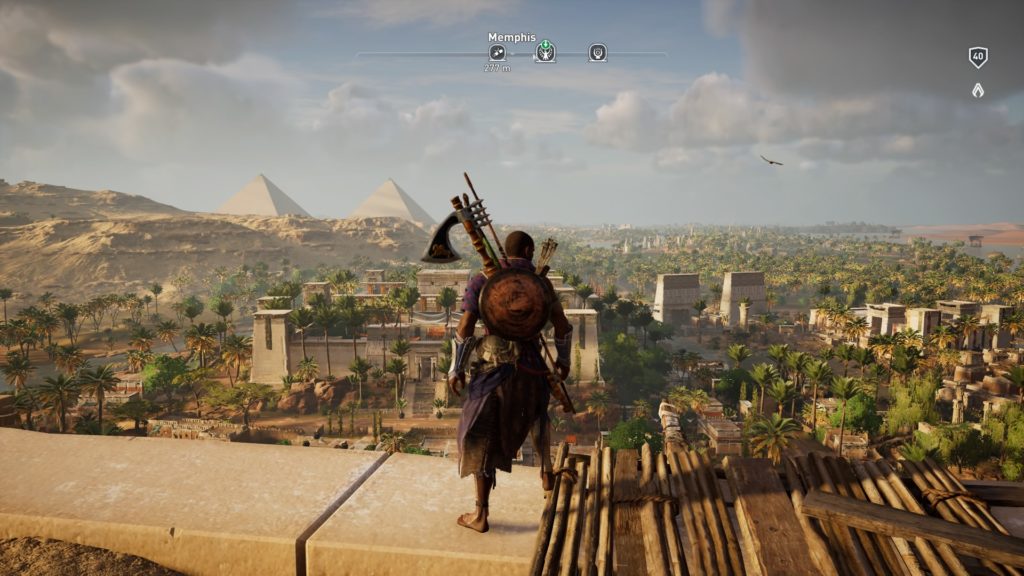
Isn’t Memphis pretty
I’m used to playing adventure games. I love puzzles, talking to in-game characters and hunting for clues. Usually these are linear point-and-click games, but now I had an open world sandbox to explore. I could now run, climb, swim, ride, sail and fly. After getting used to the controls, I was very happy to climb pyramids (the somewhat eroded outer layer providing handy footholds), enter Djoser’s underground chambers and loot abandoned cliff tombs. Yes, loot. That most vile of archaeological pursuits advocated by the likes to Indiana Jones and Lara Croft became second nature as the need arose to get cash, weapons and other items. Fortunately the character you play is a good guy, so you also end up helping many locals, hunting dangerous crocodiles and hippos and being very friendly to kids.
Bayek, the main protagonist, is a Medjay, an anachronism we can forgive the game for the sake of the narrative. The historical medjay were a sort of parmilitary police force charged with protecting royal assets in Thebes during the New Kingdom, the name derived from an ancient nomadic tribe. Bayek is such a Medjay or protector from the Siwa Oasis, while is wife Aya gets more and more involved in the international politics of Cleopatra VII. This means that at some point you must climb the Lighthouse of Alexandria, and incidentally have a hand in several famous historical events.
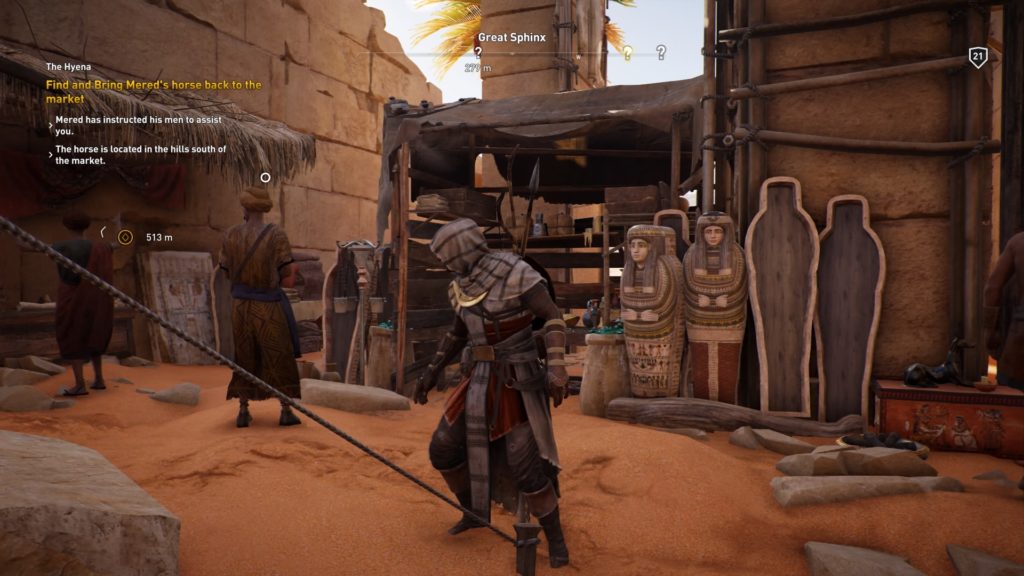
Find your sarcophagus at the local market
The land is vast and there is a clear distinction between city and countryside, the lush Nile delta and the barren desert. You get a good idea of distances covered, although obviously for the sake of gameplay the north of Egypt has been compressed somewhat. During this historical period, the country’s population consisted not just of Egyptians but also of Greeks and (more or less invading) Romans. These groups are distinguished by appearance, clothing, names, speech and locality (Egyptians living in more rural areas whereas Alexandria is flooded with Greeks), although there is occassional mingling. The Egyptians are generally protrayed as the underdog. This mixing of cultures is cleverly used in the game, allowing you to fight in arenas as well as enter the Egyptian underworld and attempt to kill Apophis while balancing on the bark of Ra. There are numerous side quests so you are not constantly fighting. There are RPG elements, you can buy and sell weapons, mounts and outfits (my favorite being the hamam towel), there is crafting and hunting to be done while you try to level up and collect abilities.
Your trusty Bonelli’s eagle Senu is your pair of eyes from the sky. You can spot enemies a mile away, as well as take in the pretty view. The vibrantly colourful environment is alive, full of people, wildlife and ruins. The game merges history with fantasy and sci-fi elements. Cleopatra is protrayed as a femme fatale while Caesar looks just like his equivalent in the Asterix comics. Unfortunately, I haven’t located any properly decorated mastaba tombs (although there is a rather pleasant fight with a sorceress that takes place largely on top of a mastaba field).

From the top of a pyramid, overlooking a cemetery
It is a pity that the discovery mode – that consists of guided tours – lets you interact with the environment only in a very passive way, while the story itself doesn’t make you slow down enough to admire its more Egyptological content. For educational purposes, you would still need to make your own videos explaining what is based on historical reality and what is pure fantasy (which I aim to do at some point when no one is probably waiting for it anymore).
The funny thing is that I was actually hesitant to kill animals in the game (no trouble with Romans though – although I did disable the blood effect). There are so many things to do that sometimes you get side tracked for hours. In the end, the quests are still linear, as there are no real consequences to your actions (except dying and having to redo a mission). There was a point where I didn’t want to continue because I didn’t want to influence history by performing an action, but I could bribe no one else in the house to press the required button.
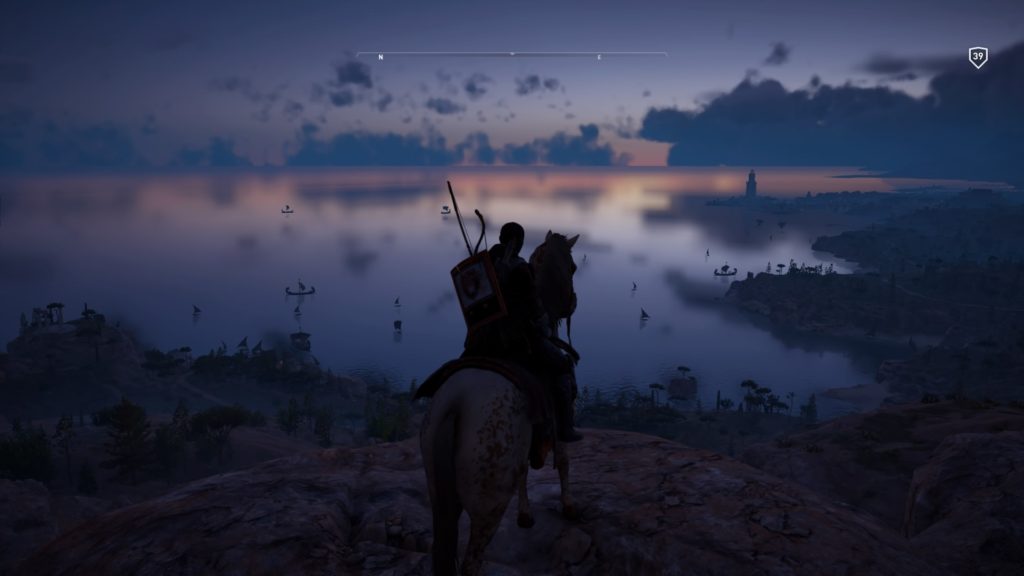
The early bird catches the worm
Several ancient Egyptian concepts are thrown your way that the average player may not be aware of. There is the contrast between the red (desert) and black (fertile) land (in the game more yellow desert vs. green cultivation), the Medjay (of which you seem to be the last), the concept of Maat (Bayek uses a feather to judge assassinated enemies and send them to the underworld), and there are curses to be countered (albeit perhaps more in a modern than ancient sense).
There are plenty of animals (gazelles, ibex, lions, panthers, hyena, ibis, egrets, flamingos, vultures, sheep, goat, long horned cattle, chickens, cats, very little dogs and jackals, camels, elephants, crocodiles and hippos) and the climate appears to be more favorable, which could well be the archaeological reality. If you pay attention, you can learn about mummification, ancient brewing techniques, and how natron was collected.
There is diversity in the game, different languages are spoken, and different religions presented with their own temple types (Greek, Egyptian). Greeks will call out ‘idioti!’ and ‘parakallo’ when you run them off their feet, while I now know how the swear in two ancient languages (‘metrokoites!’ and ‘neket iadet!’). Bayek addresses people with the correct ancient Egyptian ‘seni’ (my brother) and ‘nebet’ (lady).
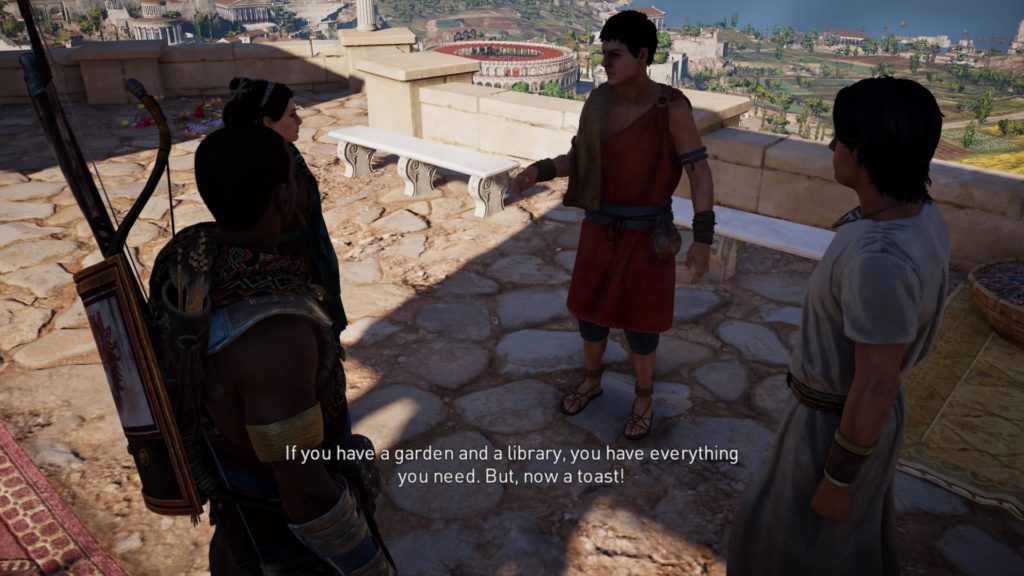
Sounds like something a Roman would say
The temples are crowded and a bit messy, with copious offerings of flowers. The banks of the Nile are busy being irrigated, the land is worked, papyrus boats abound. The soundtrack, landscape and architecture all add to the vivacity of the game. Water drops land on the ‘camera’ while you take a morning swim. The light changes throughout the day and excellent views present themselves. It is almost too pretty, too colorful. There are lovely details to be found such as the house of a painter of Fayum portraits and tombs of ancient kings (with more or less apt decoration and furniture, although the puzzle elements are a bit Indiana Jonesy).
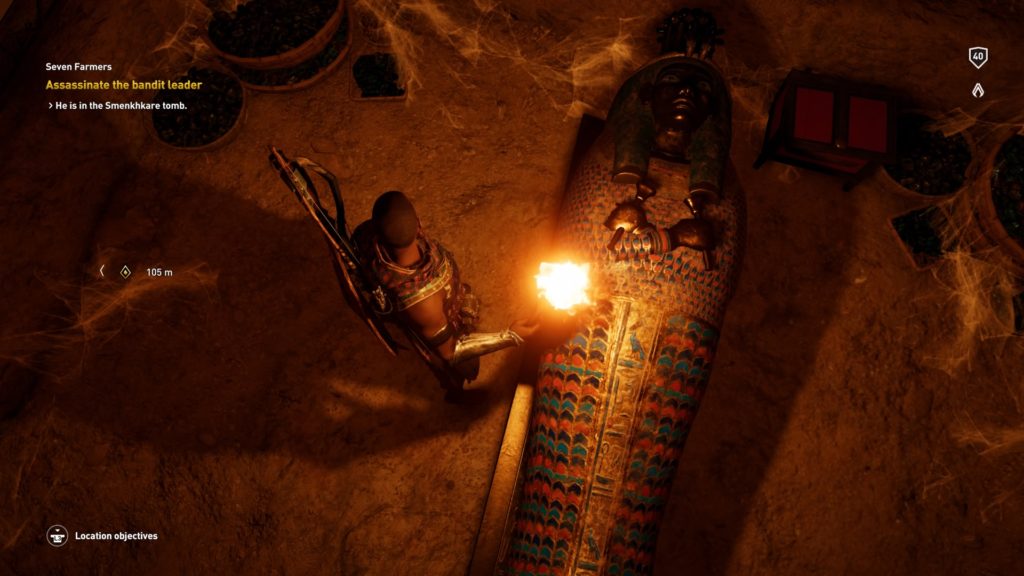
Look whose sarcophagus we found!
And when you’re a bit fed up with the regular game (after playing more or less every single side quest and having finished the main story), there are two expansions: one taking place in the Sinai, the other in Thebes. I am happily playing the Theban one now, which is very well done. I keep trying to locate the Nile Valley Hotel on the West Bank! Deir el-Bahari has been reconstructed, including its neighbouring temples of Mentuhotep and Thutmose III and there is a even a kind of Deir el-Medina. The Valley of the Kings houses many a tomb (including that of Nefertiti) as well as a gorgeous Afterlife with flying Ba-birds, endless reed fields and (admittedly) rather Stargate-like Anubis guards.
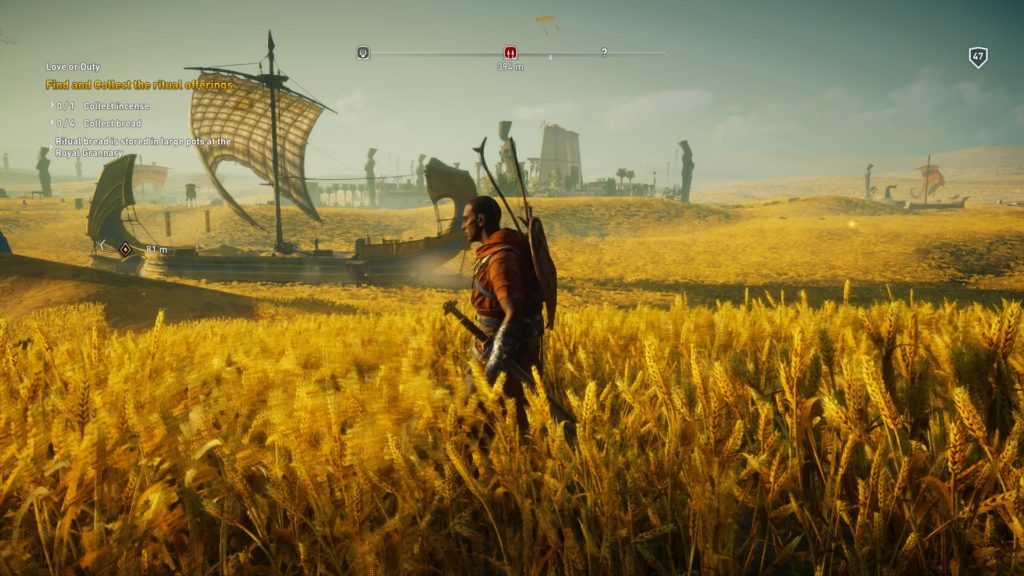
In the Field of Reeds
I recommend this game to every Egyptologist. On level ‘easy’, you will quite effortessly be able to hide in shallow bushes, and aim assist will help you, well, aim. It is highly enjoyable to climb pyramids and locate the many Egyptological gems in the game. I truly think games like these can help educators teach about ancient societies, although a lot of ‘parsing’ still needs to take place. Budgets in the mainstream gaming industry are incredibly high, and there is much more truth in a game like this, that was created with the help of actual Egyptologists, than you will find in any movie. The only problem, education-wise, is that the game is for 18 and over. I did let my nephew play in ‘safe mode’ though, and he was much faster than me in navigating the environment.
Next to books, it was games that made me decide (more or less moronically) to study Egyptology. If we can interest new audiences in ancient history and society using games, how cool is that?
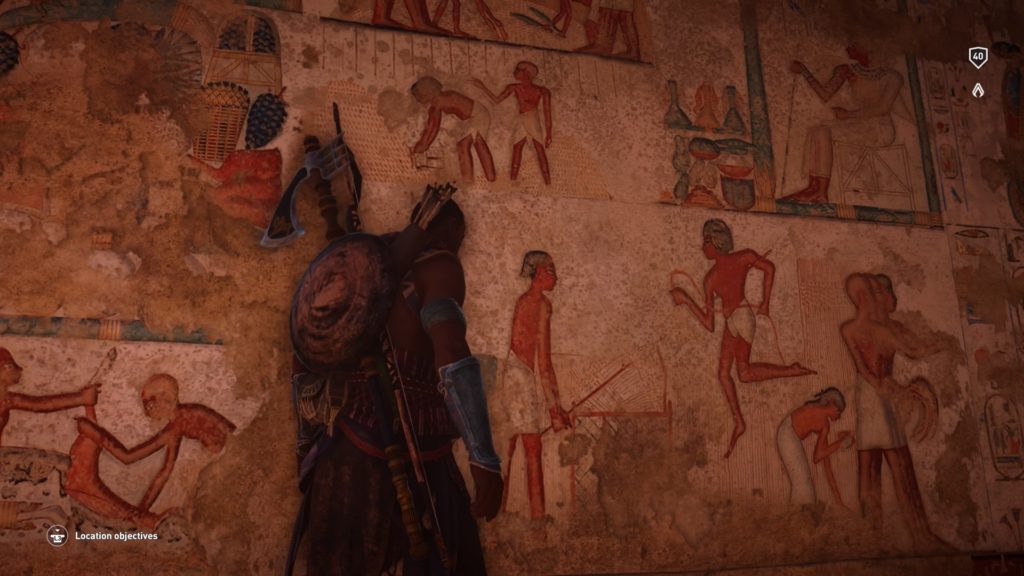
Does this look Theban to you?
